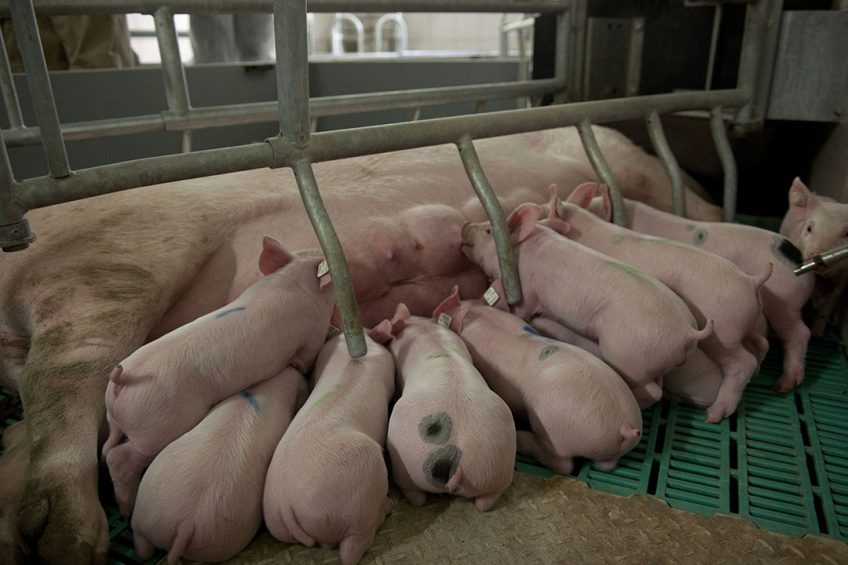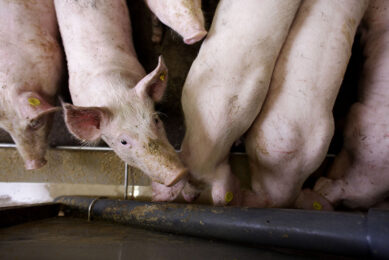Is there one method fits all to measure sow herd efficiency?

Comparing sow herd performance is not always easy as sometimes different farms apply different calculations or metrics. Which metrics would really make sense and when applied, do the same farms still emerge on top? US researchers found an answer – and the question, indeed – was rhetoric.
The ability to maintain sow lifetime histories and to report herd performance has improved markedly over the past 40 years as computer software has evolved to take advantage of faster and larger computer processing capacity. Over the years, algorithms to report weaned pig production in databases which include Part Wean and Nurse Sow events together with regular weanings, have become faster and more accurate.
2 popular measures used to assess sow herd productivity are Pigs per Sow per Year (PSY), and the much preferred, ‘Pigs Weaned/Mated Breeding Female/Year (PW/MBF/Y)’ as defined by the National Pork Board’s Production and Financial Standards. These measures are frequently used by breeding herd owners and managers to:
- Assess breeding herd productivity;
- Benchmark the productivity of their herds against other operations within their production system (if they are a part of a larger number of sow herds) or against other, similar operations;
- Compare herd productivity with herds using different genetics; and,
- Compare the productivity of their operation against other operations around the world.
What is challenging about PSY?
The challenging part of using PSY is that not all record keeping systems calculate the measure the same way. Furthermore, some producers and managers have learned how to creatively manage records in order to inflate PSY. This can be accomplished by waiting until after a replacement gilt is mated or even farrowed, to enter the animal into the record system. Thus, the non-productive days that are accumulated by the typical 15% of replacement gilts that are selected but never farrow, are not accounted for, which inflates the reported PSY for the particular herd that utilises this practice.
As it ignores the gilt pool and considers only mated breeding females, PW/MBF/Y is a more reliable measure of weaned pig production. Most record systems used by sow farms calculate PW/MBF/Y the way it is described in the Box. There, formulations for the calculation of L/MBF/Y and PW/MF/Y can also be found.
Farrowing rates approaching 90%
Because farrowing rates approach 90%, computer record keeping systems tend to credit all mated breeding females with (productive) gestation days between their service dates and due-to- farrow dates. Mated females are presumed to be pregnant until a gestation terminating event is entered into the system.
This results in the gestating days for the sows (gilts) that are currently gestating being overestimated. After each animal farrows, entry of the farrowing event and thus the number of gestation days becomes a ‘known’ or ‘hard’ number. In the case of gestation-terminating events which do not result in farrowings (e.g. fail to farrow, found open), the presumed productive gestation days are ‘unwound’ and converted into non-productive days.
Many producers still enter litter data collected from the farrowing barn after weaning. Where farrowing, piglet death, foster and weaning data are entered into the record system at the same time, this means that it may be the end of May before the productive and non-productive days for the previous calendar year, and thus PW/MBF/Y are finalised. The ever-changing numbers in the current five months of the production reports and the enforced lag before finalising numbers for a calendar year or quarter are often a source of frustration for those involved in benchmarking.
Metrics with limited value
Due to the limitations of PSY or PW/MF/Y, these metrics have limited value other than ‘bragging’ rights. Many people involved with swine records have advocated that the industry adopt metrics that have ‘real’ economic meaning for the commercial breeding herd. One metric is pigs produced per sow day of life. However, this requires that the birth date of each sow is known and recorded accurately in the database.
Where the birth dates for incoming replacement females are unknown, an alternative would be to evaluate pigs produced per day of herd life, between herd entry and removal dates. Looking at day of herd life has more of an economic impact due to accurate accounting for non-productive days, For example, a gilt that is in the herd for only ten days and never produces a pig has the same impact on pigs per sow per lifetime as a gilt that was in the herd for 150 days and never produced a pig.
Considerations of herd life metrics requires that the producer consistently enter incoming gilts at a constant point within the gilts’ production cycle. For example, gilts could be entered in the record keeping system after their first heat-no service event, or earlier when they begin the isolation period on the sow farm. Whatever time period is chosen, producers should strive to maintain that time frame for entering replacements into the record keeping system in order to compare the productivity of females across time.
Pigs weaned per sow lifetime
The calculation for pigs weaned per sow lifetime can be found in the Box. Expressing pigs weaned per day of life or per day of herd life (PW/DHL) can be accomplished by simply dividing the number from the above equation by the sum of the number of days each qualifying sow was present in the herd, i.e. (Removal Date – Herd Entry Date) + 1.
Typical numbers for PW/DHL are very small, ranging between 0.05 and 0.09. Therefore, as a practical consideration, it makes sense to multiply the result by 100, and express the metric as Pigs Weaned per 100 Days of Herd Life (PW/100DHL)
Making comparisons for sow herds
In order to compare how sow herds would rank if evaluated using PSY (PW/MBF/Y), or per sow lifetime, or PW/100DHL, we asked colleagues at Swine Management Services to help make this comparison data from real sow herds. The data was generated based on the females removed from each herd over the last three years, more than 62,000 sows in total. Thanks to Valerie Duttlinger, Ron Ketchem and Mark Rix they were able to provide the following data.
Table 1 shows the performance from 13 commercial sow herds. The average parity at culling ranges from 3.75 (Herd 12) to 6.00 (Herd 10). The lowest number of pigs per female per lifetime (41.3), is consistent with the herd with the lowest average parity at culling (3.75); but the herd with highest P/F/L (60.1 in Herd 1) averaged 5.07 parities at culling.
Highest number of pigs weaned
Herd 9 has the highest number of Pigs Weaned per 100 Days of Herd Life (PW/100DHL) at 8.48; Herd 12 is lowest at 6.25. While Herd 9 is not the best for average parity at culling, it is the best herd for pigs weaned per female per day of herd life and 1 of the top 3 for the percentage of females that did not farrow.
This combination allows this herd to have the best PW/100DHL and is just a bit below the middle of the pack for pigs weaned per female per lifetime. When examining the herds for the highest total born per female per day of life, herd 11 comes in at 9.30 and the herd with the lowest value for the same trait is herd 12 at 6.60.
When examining the 1- and 3-year summaries for pigs weaned per mated breeding female per year (PW/MBF/Y) a completely different picture emerges. 2 different formulas were used to calculate PW/MBF/Y:
- The first used the NPPC Production and Financial Standards formula
- The second used a commercial record keeping system’s formula.
In the one-year summary it is possible to see both the NPPC and the commercial software values identified the same herd with the best PM/MBF/Y from herd number 2. However, from ranking 3 through 13 each system had different herds ranking at different positions. Comparing the NPPC and the commercial formulas in their ranking of the 13 herds for 3-year average of PW/MBF/Y appears to be a bit more consistent with each other although they do flip the top two herds, herds 2 and 8, for the top spot in this ranking.
No top producers identified
But what should be clear is that none of the top producers identified for lifetime productivity, herd 1 for pigs/female/lifetime and herd 9 are identified as the top producer if just examining pigs weaned per mated breeding female per year. What is even clearer that if evaluating the herds based only on pigs weaned per mated breeding female per year, herd 9 would appear near the bottom in both the one and three-year summaries (Table 2). But herd 9 has the best combination of productivity and lowest non-productive days as indicated by having one of the lowest percentages of sows not farrowing a litter.
Would producers rather have bragging rights and have the best P/S/Y (PW/MBF/Y) or would they rather have the most productive herd with the highest number of pigs produced per 100 days of herd life (PW/100DHL)? Swine production record keeping system already reports the Pigs Weaned/Sow Lifetime statistics. As this article has shown, it would not take much effort to add and report the Pigs Weaned/Per 100 days of Herd Life (PW/100DHL) metric and give the ability to get a better assessment of a sow herd’s efficiency.
Doing the mathsThe following formulas apply in the article. PW/MBF/Y = (Pigs Weaned/ Female Weaned) x (Litters/ Mated Breeding Female/ Year (L/MBF/Y)) L/MBF/Y = (Gestation Days in Period/ total mated sow days) x 365/115 days PW/MF/Y = (Pigs Weaned/ Days in Period x 365)/ (Total Mated Sows Days/ Days in Period). The calculation for pigs weaned per sow lifetime is: (Pigs Weaned Lifetime from Females Culled, Died and Euthanised in report period) (Females Culled + Females Died + Females Euthanised in report period) |
Co-authors: Valerie Duttlinger, Swine Management Services, Fremont, Nebraska, USA; and Will Marsh, Decision Power, Little Canada, MN, USA











